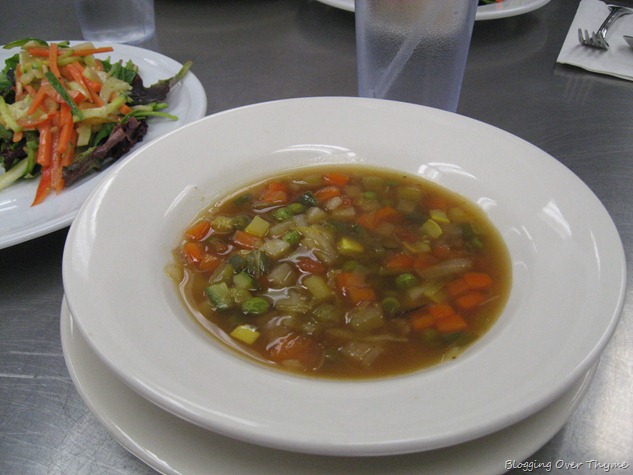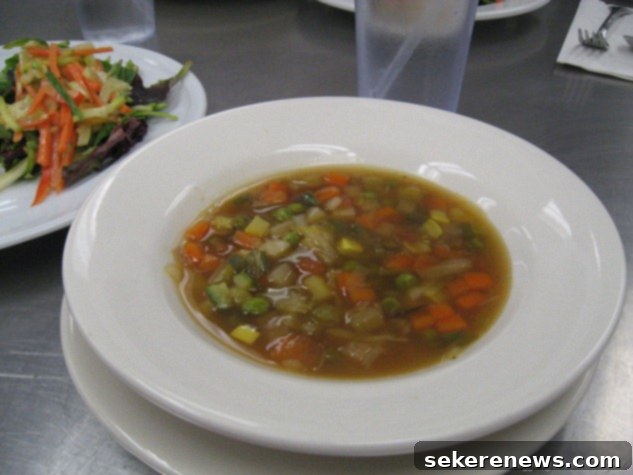Culinary School Unveiled: Mastering Potage, Quiche, and Essential Kitchen Skills in Week One
It’s hard to believe that our first exhilarating week of culinary school has already drawn to a close. The days flew by in a blur of intense learning, new techniques, and unexpected challenges. I’m still pinching myself, trying to process the reality of embarking on this incredible culinary journey!

Diving into French Classics: Potage Cultivateur
Our Friday class was dedicated to a fundamental French dish: POTAGE CULTIVATEUR. For those wondering about the capitalization of menu items, it’s a clever trick to bypass the complexities of French accents – a convenience I’ve quickly come to appreciate!
As we discovered in our morning lecture, a Potage Cultivateur translates literally to a ‘Farmer’s Soup.’ It’s a testament to resourcefulness, traditionally crafted from a medley of seasonal vegetables readily available. This concept highlights a key distinction between a potage and a common soup, a term most of us use daily. A true potage almost invariably begins with leeks and carries a more refined “pedigree” or structured approach to its preparation.
In contrast, a standard soup is often less formally defined, typically starting with onions or whatever ingredients are at hand. It’s generally a more casual creation, lacking the specific starting point and subtle elegance associated with a potage.

For our Potage Cultivateur, we used a diverse range of fresh ingredients in roughly equal proportions: vibrant leeks, earthy turnips, crisp cabbage, sweet carrots, starchy potatoes, tender peas, aromatic celery, ripe tomatoes, sunny yellow squash, and versatile zucchini. And, of course, a touch of bacon was added for an extra layer of savory depth. One of the prevailing lessons in culinary school seems to be: when in doubt, add bacon or cook with its rendered fat. While I don’t always fully concur with this philosophy, I’m certainly embracing the curriculum!
Mastering Knife Skills for Uniformity and Flavor
A primary objective for preparing this potage was to hone our knife skills, an area that demands constant practice and precision. For any soup or stew, achieving uniform ingredient size is paramount. The fundamental reason for this meticulous chopping is to ensure every component cooks evenly, preventing some vegetables from becoming mushy while others remain undercooked. Beyond functionality, uniformity also contributes significantly to the dish’s aesthetic appeal. As our chef sagely noted, you certainly don’t want to lift a spoon to find a single, disproportionately large piece of one ingredient dominating the entire spoonful.
For this specific potage, we were tasked with chopping every vegetable into a precise small dice, meaning perfect 1/2 inch by 1/2 inch cubes. This size was chosen to be consistent with our frozen peas, ensuring a harmonious texture throughout the soup. The cooking process began by ‘sweating’ the leeks, a technique involving gently cooking them over low heat to release moisture without allowing them to brown. This process softens their texture and mellows their flavor. Following this, we added stock and then incorporated the remaining vegetables sequentially, according to their individual cooking times – the longest-cooking vegetables going in first, followed by those requiring less time, ensuring perfect tenderness for each.

The Invaluable Practice of Mise en Place
One of the most profound lessons consistently emphasized in culinary school, practically daily, is the indispensable importance of preparing your MISE EN PLACE before initiating any cooking task. This French term literally translates to “everything in its place,” and its significance cannot be overstated in a professional kitchen. For our potage, this meant meticulously chopping each vegetable and arranging every ingredient into small, reusable containers (we use deli cups at school). This structured approach ensures that once the cooking begins, you maintain complete control, avoiding frantic searches for a forgotten item and making the entire process efficient and enjoyable. This step has quickly become one of my favorite parts of cooking! I wholeheartedly encourage everyone to try incorporating mise en place into their home cooking routine, even just once; you’ll find it makes the experience significantly more stress-free and relaxing.
Crafting the Perfect Quiche Du Jour
In addition to the potage, our task for the day included preparing another quiche. This was our QUICHE DU JOUR, a “quiche of the day” made with whatever ingredients were on hand. Since we all had leftover pate brisee dough from previous lessons, the chefs wanted us to further practice the fundamental techniques of rolling out dough, molding it into a tart pan, blind baking it (pre-baking the crust to prevent it from becoming soggy), and docking (piercing the bottom with a fork to prevent air bubbles from forming and the crust from puffing up). To introduce some variety, this time we created a roughly 8-inch quiche, filling it with a delectable combination of creamy goat cheese, fresh asparagus, earthy mushrooms, and… you guessed it… bacon!

To ensure all components were perfectly cooked within the quiche, we pre-cooked both the asparagus and mushrooms. The mushrooms were evenly sliced and then quickly sautéed – a term meaning to “jump in the pan” – over high heat with minimal clarified butter. The goal here was to drive out as much moisture as possible, preventing it from leaching into the quiche filling and making it watery.
The asparagus received similar careful treatment. We began by peeling the lower two inches of their stalks to remove any tough fibers, then plunged them into vigorously boiling water generously seasoned with salt. Cooking asparagus in highly salted boiling water is a technique that helps preserve their vibrant green color while enhancing their natural texture and flavor. Once cooked to tender-crisp perfection, they were immediately transferred to an ice bath to halt the cooking process, ensuring they didn’t become overcooked. After blotting them thoroughly dry to remove excess moisture, they were chopped and ready to be added to the quiche.
Completing the Meal with La Salade Composée
To round out our culinary offerings for the day, alongside the potage and quiche, we assembled a vibrant LA SALADE COMPOSÉE, or a ‘composed salad.’ This involved meticulously julienning (cutting into thin matchsticks, precisely 1/8 inch by 1/8 inch by 2 inches) bell peppers, carrots, celery, and cucumber. We also utilized our sharp chef’s knives to thinly shave a fennel bulb, adding a delicate anise flavor and elegant texture to the mix. I sincerely hope that these delightful and healthy vegetable dishes continue to be a regular feature on our daily menu for the foreseeable future!

All these freshly prepared dishes, complete with perfectly set utensils and water glasses, had to be ready for service by 11:45 AM. This is when the Phase I pastry students join us, not only to share a meal but also to enjoy the fruits of our labor. Friday’s quiche, I must admit, was even more delicious than the one we made earlier in the week. My love for goat cheese, coupled with the inclusion of asparagus and mushrooms – two of my absolute favorite vegetables – made it a true highlight. The crisp salad and light vegetable potage provided a refreshing and colorful accompaniment, making for a truly satisfying meal.

A Sweet Ending and the Reality of Kitchen Chores
As is customary, the pastry students reciprocated, bringing us their delectable creations for the day. This time, we were treated to homemade coffee-flavored éclairs and delicate profiteroles. I simply couldn’t resist indulging in an éclair, and it was utterly delicious – notice how elegantly smaller these authentic French versions are compared to the often-ginormous ones found in many American bakeries!

After a satisfying lunch came the less glamorous, but equally crucial, task of cleaning. For me, this proved to be quite labor-intensive. I volunteered for the monumental task of cleaning the enormous stockpot that had previously held chicken stock. This was our first time as students being responsible for this particular piece of equipment, and it was certainly an ‘interesting’ experience.
As I mentioned, whenever a batch of homemade stock is used throughout the school, our group is assigned the duty of thoroughly cleaning the massive stockpot and initiating the next batch. This involves carefully removing all the cooked bones and the spent mirepoix (the classic aromatic base of onions, celery, and carrots), which, after stewing for hours and hours, takes on a rather unappetizing appearance, as you can see:
Not exactly a pretty picture, but a necessary part of the process…

Cleaning this colossal pot required stepping onto a foot ladder and literally using another large stockpot to scoop out its weighty contents, which probably tipped the scales at close to 50 pounds. These remnants were then carefully deposited into a heavy-lined trashcan before the real scrubbing began, from top to bottom! Kevin, a classmate, and I armed ourselves with a very large bristle brush, scrubbing relentlessly back and forth until the pot finally gleamed, sparkling clean once more. I jokingly suggested to our chef instructor that the inventor of these stockpots should have incorporated a “self-clean” feature! Each of those stubborn, dark rings around the edge, a testament to hours of simmering, was meticulously scrubbed away. The entire task took Kevin and me nearly 45 minutes to complete – perhaps I successfully burned off that éclair after all?
The Science of the Kitchen: Weights, Measures, and Knife Care
The remainder of our afternoon was spent in the classroom, delving into a critical discussion on weights and measures. In the culinary world, particularly in professional settings, knowing your measurements – especially volume in our curriculum – backward and forward is absolutely essential. For instance, if someone asks how many teaspoons are in a gallon, we must be able to respond instantly and accurately. Precision is paramount in cooking and baking, transforming ingredients into perfect dishes. Oh my, there’s certainly a lot to commit to memory!

We also had an exciting session learning how to properly hone our knives. Honing, performed with a honing steel (like those pictured above), is crucial for maintaining a knife’s edge alignment and keeping it sharp. It’s important to understand that honing doesn’t actually sharpen a dull blade; rather, it realigns the microscopic metal particles along the cutting edge that have bent out of shape during use, restoring the blade’s initial sharpness. However, improper honing can actually damage the blade, so technique is key! We are expected to hone our knives at least once, if not multiple times, throughout a cooking day. As a practical rule of thumb, our chef instructed us that we should be able to effortlessly slice through the skin of a ripe tomato with our chef’s knife every single day.
Sharpening, conversely, is a distinct process performed with a wet stone (available in various grits suitable for different knife materials). Sharpening literally involves abrading and removing a tiny amount of metal from the blade, creating a new, sharper edge. By regularly honing your knives, you significantly reduce the frequency with which you need to sharpen them. This is crucial because each sharpening session, while necessary, incrementally decreases the overall size and lifespan of your knife.
Chef Brian also offered invaluable advice: you should probably never spend more than $100 on a chef’s knife, especially when you’re just starting out. Ultimately, the true utility and effectiveness of your knife in daily use depend far more on consistent maintenance through honing than on its initial cost. Therefore, owning a $200-$300 chef’s knife will not serve you well in the long run if you neglect to hone it regularly.
I found all this information incredibly fascinating and definitely dedicated time to practicing my honing skills this past weekend! I’ll be back soon with more tales from culinary school. Who knows what new adventures and lessons await us this upcoming week!
P.S. Don’t forget to check out my culinary school page, which features an excellent video showcasing my school’s culinary arts program! I’ll be updating this page with even more content very soon…
